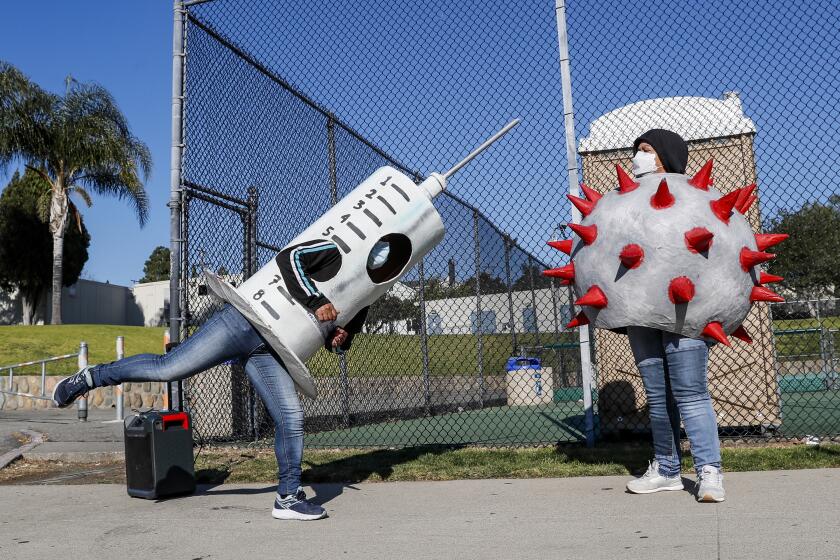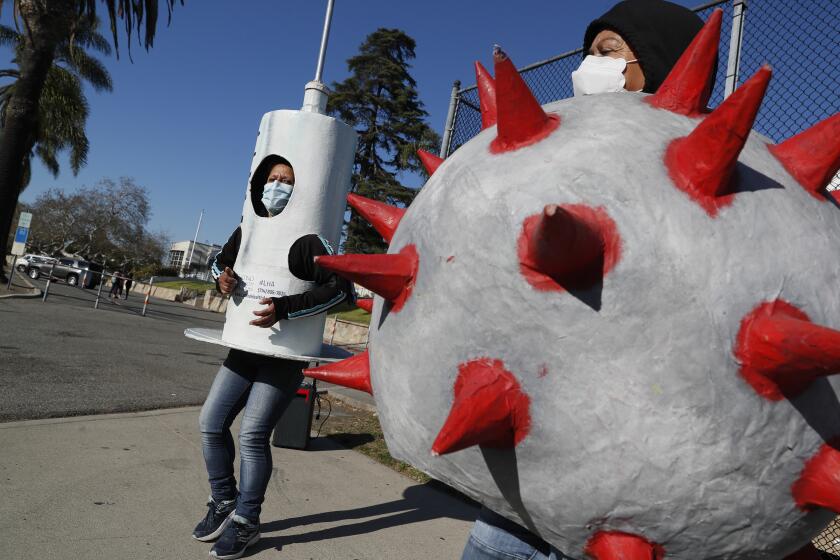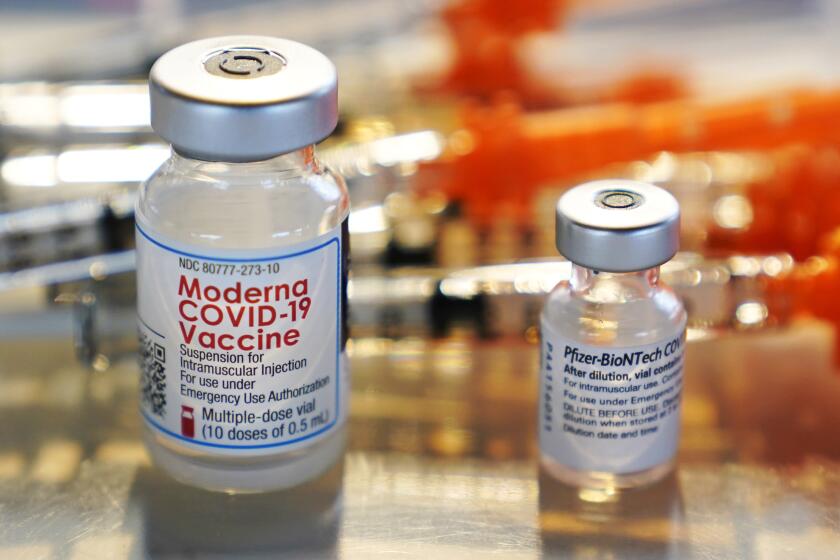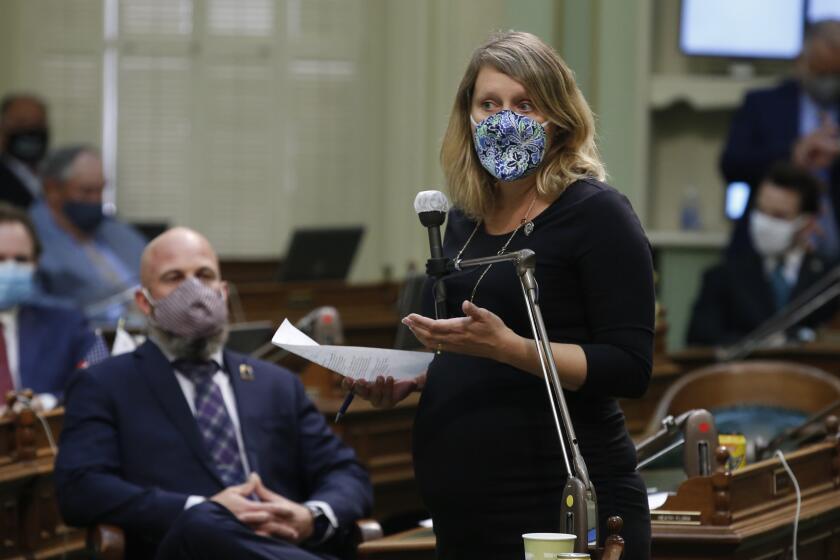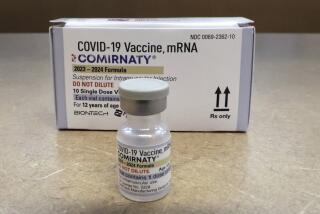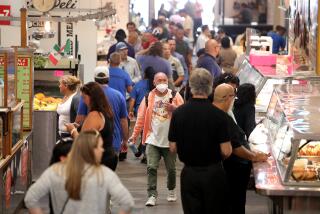Ultra-contagious BA.2 Omicron strain adds urgency to second booster shot
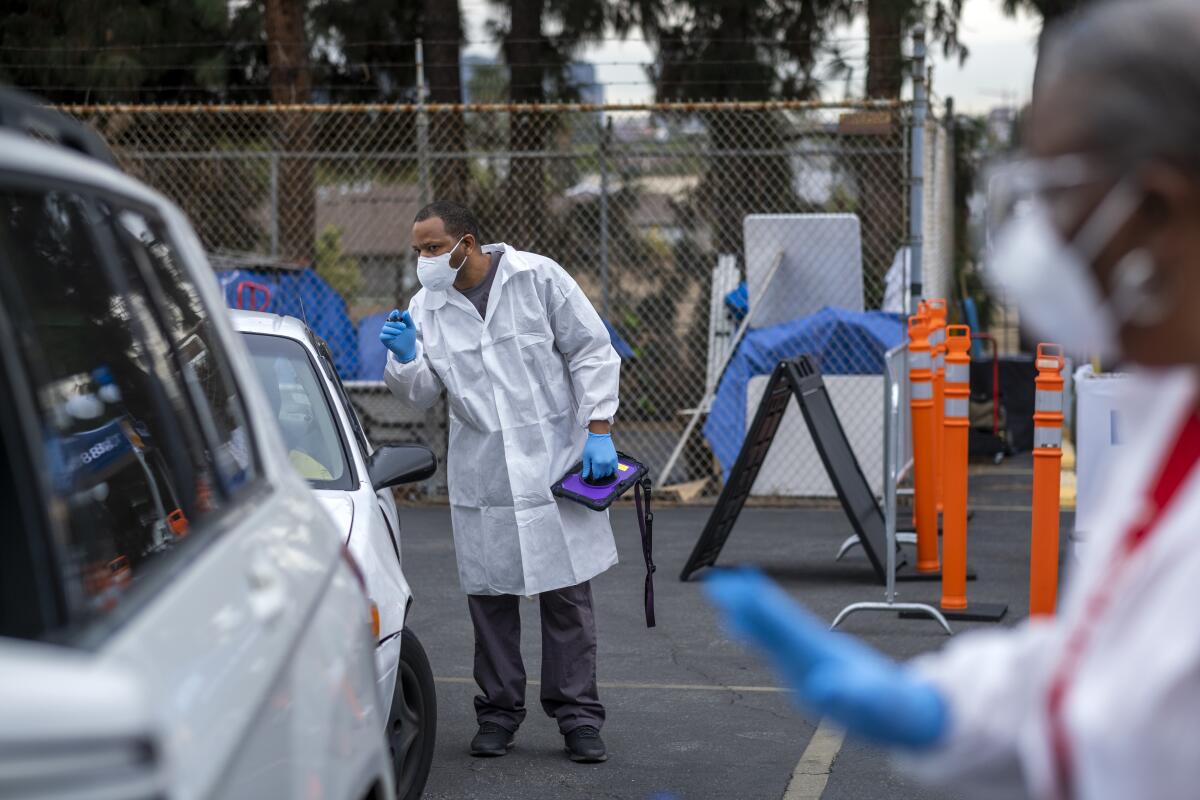
The highly contagious BA.2 Omicron subvariant is now the dominant version of the coronavirus in the U.S., including the West Coast — a development that added urgency to federal authorities’ decision Tuesday to allow a second vaccine booster shot for those age 50 and up.
The Los Angeles County Department of Public Health will be ready to offer second booster shots to those in that age group starting Wednesday at seven clinics.
An additional shot “is especially important for those 65 and older, and those 50 and older with underlying medical conditions that increase their risk for severe disease from COVID-19, as they are the most likely to benefit from receiving an additional booster dose at this time,” Dr. Rochelle Walensky, director of the U.S. Centers for Disease Control and Prevention, said in a statement Tuesday.
Under the new authorization, a second booster dose will be available to those who are at least four months removed from their first booster. This would be the fourth dose for those who were originally vaccinated with the two-dose Pfizer-BioNTech or Moderna vaccines and a third for those who originally got the single-shot Johnson & Johnson.
Officials will continue to study the need for a second booster dose for Americans younger than 50.
The CDC on Tuesday also made a special allowance for all adults who received a J&J initial dose and J&J booster: They are authorized for a second booster, of either Pfizer or Moderna.
Here’s how to get your second COVID-19 booster shot if you are 50 or older.
Boosters are important because there’s evidence of “some waning of protection over time against serious outcomes from COVID-19 in older and immunocompromised individuals,” Dr. Peter Marks, director of the Food and Drug Administration’s Center for Biologics Evaluation and Research, said in a statement.
The CDC has suggested that the Pfizer or Moderna vaccines be used for either first or second boosters in most situations. A CDC study published Tuesday found that a Pfizer or Moderna booster following an initial J&J shot was more effective at protecting against hospitalization than a J&J booster.
The CDC has already recommended that those 12 and older with moderately or severely compromised immune systems who originally got the Pfizer or Moderna vaccine get a fourth dose, and those with weakened immune systems who originally got the J&J vaccine get two additional doses.
A Mexican immigrant is a foot soldier in the drive by nonprofits and healthcare providers to close the Latino COVID-19 vaccination gap in Orange County.
Dr. Peter Chin-Hong, a UC San Francisco infectious-diseases expert, said in an interview that if he were advising his relatives, he might want those 65 and older — and especially those 75 and older — to get the second booster. It’s less urgent for a relatively healthy person in their 50s, he said. But a second booster would provide an antibody boost that may help “protect them against getting a breakthrough infection.” An additional dose might also be helpful for people who are traveling and want to take additional steps to avoid getting infected.
Chin-Hong noted that the boosters are safe.
“You don’t get immune exhaustion; you don’t get more side effects,” he said. “It’s well tolerated.”
It will take time for researchers to determine how much additional benefit a second booster will provide. There is a clear benefit after completing the initial vaccination series and again following the first booster, Chin-Hong said. However, early data from Israel suggest that the benefit of a subsequent shot isn’t as substantial.
“We do note waning immunity following the third dose,” said Dr. Robert Kim-Farley, a UCLA epidemiologist and infectious-disease expert. “And in some studies, a fourth dose has been able to bring the antibody level back up to what it was shortly after the third dose. That would imply additional protection.”
The FDA has authorized another booster dose of Pfizer and Moderna’s COVID-19 vaccines for people age 50 and up, and the CDC endorsed the decision.
The expanded booster availability arrived the same day the CDC published data estimating that BA.2 — an even more infectious version of the coronavirus than the one that swept across California over the winter — accounts for a majority of new cases nationwide.
Over the week ending Saturday, BA.2 made up an estimated 55% of samples nationally, according to the CDC, up from 39% the previous week. In the Southwest — including California, Arizona, Nevada and Hawaii — BA.2 made up an estimated 60.5% of coronavirus samples that week, up from 45%.
The bill would have required employees and independent contractors to be vaccinated against COVID-19 as a condition of employment unless they have an exemption based on a medical condition, disability or religious beliefs.
There have yet to be signs of a sustained increase in new coronavirus cases nationally and in California. In Los Angeles County and across the state, case rates remain at their lowest point since last July, before the Delta surge.
California’s weekly case rate is now 50 for every 100,000 residents, down from 70 in early March, according to data from Johns Hopkins University.
But about a dozen states are observing an uptick — including New York, where the weekly case rate has risen from 58 for every 100,000 residents to 105. BA.2 became dominant in the Northeast before it did on the West Coast.
Some experts say they expect an increase in cases nationally this spring — a likelihood that could be fueled by the spread of BA.2 and worsened by reductions in public masking and increases in travel and gatherings.
BA.2 has already fueled substantial increases in other countries, demonstrating how readily the subvariant can spread.
In Britain, weekly coronavirus cases have more than doubled since late February, and hospitalizations and deaths are climbing.
Many Americans are significantly relaxing how often they wear masks and take other once-routine coronavirus precautions.
Fueled by BA.2, Britain’s weekly case rate is now about 40% of its winter Omicron peak. There are reports of hospitals coming under pressure, a result of healthcare staff needing to be sent home due to coronavirus infections, according to the BBC.
Many experts believe California is well-armored against another significant surge, as the vast majority of residents have either been vaccinated or have some natural immunity from a recent infection. But researchers predict that California will see rising cases.
“We will have a wave. The only question is how big it will be,” tweeted Dr. Eric Topol, director of the Scripps Research Translational Institute in La Jolla.
Added Scripps microbiologist Kristian Andersen: “I expect we’ll see a wave — I don’t know if it’ll be a surge.”
South Korea says its daily average of new coronavirus infections declined last week for the first time in more than two months.
Kim-Farley of UCLA doesn’t expect a major surge in the state, “just because so many people are immune, due to vaccination or to natural immunity from a recent infection.” He has said he’d be more concerned about a new variant that would render existing immunizations and natural immunity less effective. He expects the likely scenario for California in the coming weeks is either a mild increase in coronavirus cases or a leveled-off decrease.
To help L.A. County avoid a springtime surge, it’s most important for the unvaccinated to get their shots and for those eligible to get their boosters, Kim-Farley said. Only 30% of the county’s 900,000 5- to 11-year-olds are considered fully vaccinated, and just 62% of its 1.4 million seniors have received a first booster.
With unvaccinated refugees from Ukraine pouring into other countries, health officials hope to avert outbreaks of COVID-19 and other diseases.
Like Kim-Farley, Chin-Hong doesn’t think BA.2 will do much damage to California in the next few weeks, partly due to the mild weather allowing people to spend more time outdoors.
At UC San Francisco’s flagship hospital at Parnassus Heights on Monday, there were just four coronavirus-positive patients; none were on ventilators. On one day in late January, there were 95 coronavirus-positive patients, 12 of them on ventilators.
Evidence is mounting that BA.2 is more contagious than the earlier Omicron subvariant. According to a new study from Sweden — not yet peer-reviewed and posted online Sunday — that analyzed nasal swab samples, the levels of BA.2 virus detected were nearly twice as high as the levels of BA.1.
“Higher viral load in the upper pharynx may at least partially explain why Omicron BA.2 is more contagious than the BA.1 lineage,” the study said.
Meanwhile, more needs to be done to promote broader public understanding of anti-COVID drugs like Pfizer’s Paxlovid, Chin-Hong said, which is taken orally and can reduce the risk of severe COVID-19 by as much as 89%.
Some experts believe California is well-armored against another potential coronavirus surge, but BA.2 has fueled substantial increases abroad.
There has been concern around recent setbacks involving COVID-19 medications. First, one of the five drugs that treats a new coronavirus infection, sotrovimab, is probably ineffective against BA.2, and the FDA on Friday said the drug is no longer authorized for use in New England, New York and New Jersey.
Second, the inability of Congress to approve new funding for community groups to vaccinate Americans — especially those who are uninsured — could worsen efforts to inoculate people living in vulnerable communities, Chin-Hong said.
In an interview Sunday on the BBC, Dr. Anthony Fauci, President Biden’s chief medical advisor, said the U.S. is headed in the right direction, with hospitalizations and deaths declining. He said he wouldn’t be surprised if eventually an intermittent COVID-19 booster is made available regularly, similar to the flu shot.
“We are going, in a gradual way, toward what we all hoped would be normal,” Fauci said. “Having said that, we need to be prepared for the possibility that we would have another variant that would come along … that does give us an uptick in cases and hospitalization.”
If that happens, he said, “we should be prepared and flexible enough to pivot toward going back, at least temporarily, to a more rigid type of restriction, such as requiring masks indoors.”
More to Read
Start your day right
Sign up for Essential California for news, features and recommendations from the L.A. Times and beyond in your inbox six days a week.
You may occasionally receive promotional content from the Los Angeles Times.
